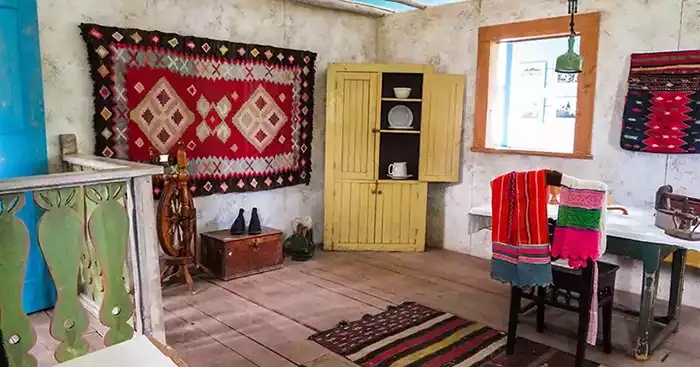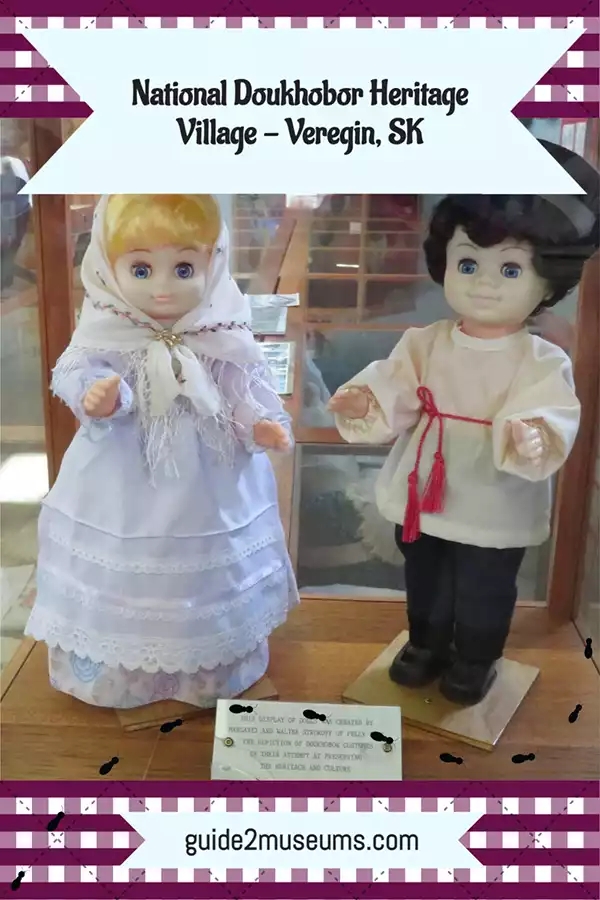The National Doukhobor Heritage Village is also known as the Veregin National Historic Site of Canada, since it received Canadian national recognition in 2006. It officially opened to tourists in 1980, becoming an important Saskatchewan cultural attraction.
What’s at the National Doukhobor Heritage Village?
In 1899, about 7,500 people of the Doukhobor faith arrived in Canada, most settling in what was then the Northwest Territories. They had suffered religious persecution for two centuries in Russia.
On June 29, 1895, the Doukhobor Community made a final stand against military service and the Tsar in Russia.

They eventually fled the country to be granted the freedom to practice their faith without military service in Canada.
Peter V. Verigin, originally exiled in Siberia, rejoined the group who had settled north of Yorkton, Saskatchewan, in 1902. With their leader once again part of the community, it began to thrive and grow.
Exhibits
Today, the village is an open air museum consisting of 13 original and reconstructed buildings all accessible to visitors. The largest is the (ca. 1917) Prayer Home, which was declared a Saskatchewan Provincial Heritage Building in 1982.

It was, however, the second prayer home built there, as the original brick one was much smaller–it still stands today, opposite the larger one.
The machine shed, grain elevator, and foundations of the old store are also early constructions. In addition to various buildings, there are a number of pieces of vintage machinery and a stone oven.
Fast Fact: A statue of Leo Tolstoy honors him for all of his efforts in finding a new home for the Doukhobors. It was presented in 1987 by the Association of Canadians of Russian descent.
A Peace Grove monument celebrates Canada’s 125th birthday. It’s in honour of Canada’s international peace-keeping role, as well as their Doukhobor ancestors. On June 29, 1895, the Doukhobors destroyed all of their weapons, making a stand for peace.

Each item inside the many buildings is labelled (if required) and provides a history of its owners. Throughout, the story of the Doukhobor settlers and their communal ideals is provided through historic photos and artifacts.
Linda’s Pick of the Exhibits
I have two favorites here, but I’ll start with the banya.
Fast Fact: A banya is a type of Russian steam-bath house. Water was typically heated with a stove.
It’s surprising to me that in an era when other settlers managed sporadic baths in folding wood or tin tubs, that there’d be a whole building set aside for cleaning purposes. In those days, it seemed only the wealthy could afford a space set aside just for bathing!
While you might expect the beautiful, big Prayer House to be my favorite, you’d be wrong. As lovely as it was, a lot of the floorspace was set aside for church services as well as management.

So, my favorite was the recreation of a Doukhobor log house. It displayed the typical craft objects brought by the settlers to Canada, including clothing and floor coverings, as well as furniture they brought or made after arrival.
I loved the wall hangings with their bright colors, the woolen blankets (and spinning wheel!), and floor rugs.
The baby’s cradle, hung from poles over the parents’ bed, was beautifully draped with fabric, no doubt to keep the child from being pestered by insects!
Linda’s Road Trip Tips
This is a great area of Saskatchewan to visit to learn more about the cultures of various early settler groups.
- Kamsack Power Museum is just over 10 minutes east on Hwy 5, with its history of Russian, Ukrainian, and Chinese heritages.
- Canora Ukrainian Heritage Museum is just a half hour west on Hwy 5.
- Get a selfie with the 7.6 m statute of Lesia (a Ukrainian girl) in traditional dress holding a traditional welcome of bread and salt.
- Preeceville is just 45 minutes north of Veregin with its 22 room museum occupying an old Nurses’ Residence. Here, you’ll learn more about Ukrainian, Scandinavian, and British settlers from this area.
Who Should Visit the National Doukhobor Heritage Village?
The open air venue makes the museum a perfect stop for families, as there’s lots of area for children to explore outdoors.
That said, the level grassy lawns are easily managed by anyone with mobility issues as well.
Anyone interested in exploring turn of the 20th century lifestyles will find this a should-see stop.
The focus here is cultural, so while there is some farming equipment, it’s a minimal display of well chosen artifacts.

Also, of course, anyone with an interest in the history of the Doukhobors in Canada will find it a must-see spot.
How Long Does It Take To Tour The National Doukhobor Heritage Village?
When you visit, allow 2 – 3 hours to go through the exhibits. Anyone with mobility issues will take longer as you have to move from building to building to see everything.
How To Visit the National Doukhobor Heritage Village
The National Doukhobor Heritage Village is located in East Central Saskatchewan on Highway #5, between the towns of Canora and Kamsack, north of the city of Yorkton.
Typically the historic site is open from mid-May until mid-September, but check for specific days, times, and admission fees on the Doukhobor Heritage website.

Keep updated on what’s happening at the village, or when/how to attend a church service, with the National Doukhobor Heritage Village Facebook page.
Plan your visit now with Google maps. If you enjoyed this article, please pin it.
Discover More Heritage Museums
- Compelling Stories of Southern Jews: New Orleans Museum
 The Museum of the Southern Jewish Experience curates the history and experiences of people from 13 southern states. Jews and non-Jewish people will find the history fascinating.
The Museum of the Southern Jewish Experience curates the history and experiences of people from 13 southern states. Jews and non-Jewish people will find the history fascinating. - Striking Doukhobor Heritage Village: Veregin, SK
 Many Doukhobor people came to Saskatcewan in the early 1900s to escape religious persecution in Russia. Visit their historic settlement in Veregin.
Many Doukhobor people came to Saskatcewan in the early 1900s to escape religious persecution in Russia. Visit their historic settlement in Veregin.









